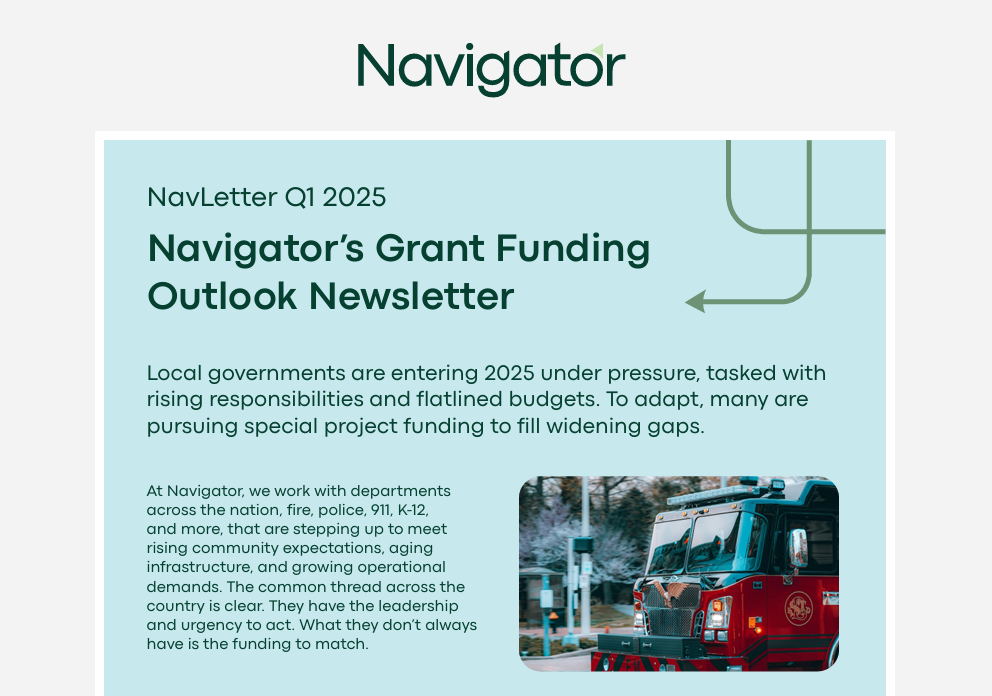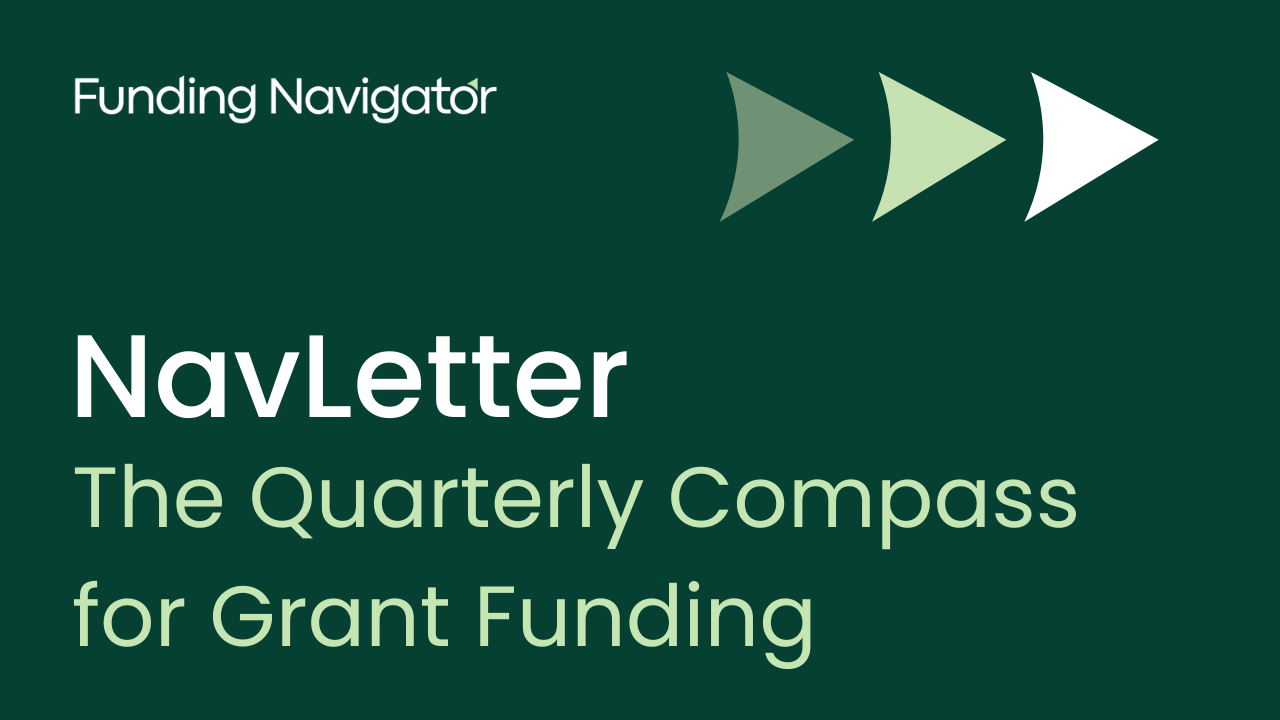At Navigator, we work with departments across the nation, fire, police, 911, K-12, and more, that are stepping up to meet rising community expectations, aging infrastructure, and growing operational demands. The common thread across the country is clear: these departments have the leadership and urgency to act. What they don’t always have is the funding to match.
That’s where special project funding plays a pivotal role. These aren’t budget line items. They’re competitive grants, foundation dollars, and capital campaigns that help departments purchase mission-critical equipment, modernize outdated systems, and launch programs that serve their communities in tangible ways. In many cases, they’re the difference between action and delay.
In Q1, we reviewed project data from nearly 2,000 departments using our platform. What we found reflects what we’ve seen on the ground: departments are prioritizing critical projects. These are not “nice to have” investments, they are the basic requirements to keep operations running. 81.6% of departments are focused on improving efficiency, whether by upgrading existing systems or implementing entirely new technology. And yet, only 32.2% have any funding secured when they begin. The urgency is real, and so is the gap.
This quarter’s NavLetter brings it all together: what departments are prioritizing, the most active federal and state programs, and what we believe will shape the funding environment for the rest of the year. Whether you’re already managing a grant pipeline or just beginning to explore what’s available, we hope this gives you a clearer view of the landscape, and a few ideas for where to go next.
Let’s dive in.
Click here to view the full report: NavLetter – A Funding Navigator Newsletter – Q1 2025

What We See in Our Data
Our analysis of Q1 2025 data, gathered from nearly 2,000 departments across the country, highlights how agencies are navigating growing needs with limited resources. The patterns that emerge point to a public safety and government sector that is focused, resourceful, and urgently seeking help to close critical gaps.
Equipment Is Still the Dominant Priority
More than 71% of departments are seeking funding for equipment, a trend that has held steady from last year. While requests still include basics like PPE, a notable share of departments are pursuing advanced tools like UAS and robotics (24.5%) and integrated technology systems (20.3%). The message is clear: departments are investing in tools that improve both safety and capability.
Life-Saving Impact Drives Most Projects
Over 90% of departments say their primary project goal is saving lives. But the impact doesn’t stop there. Reducing liability (71.1%), improving response time (60.9%), and cutting costs (50.7%) are also top drivers. This tells us agencies are not just seeking funding to survive, they’re trying to become more effective, more sustainable, and more accountable.
Operational Efficiency Is a Clear Strategy
81.6% of departments are focused on improving operational efficiency. For many, that means replacing outdated systems (68.2%) or bringing in entirely new capabilities (44.9%). Whether it’s a communications upgrade, digitizing records, or outfitting vehicles with modern tools, these aren’t wishlist items, they’re structural improvements that affect daily service delivery.
The Funding Gap Remains Wide
Despite the clear importance of these projects, most departments are starting from a financial disadvantage. Just 32.2% of departments have any funding in place when they begin pursuing a project. And only 20.7% have allocated budget for grant writing or support. These gaps help explain why even high-impact projects often struggle to get off the ground.
Internal Support Is Strong But Resources Are Thin
Departments continue to show strong internal backing, with 85.7% reporting full leadership approval to pursue funding and 93.4% managing the grant application process in-house. However, when you look deeper, the picture is more nuanced. Most departments still lack formal grant writers or funding specialists. Many applications are being led by operations staff, command personnel, or admin teams taking on grants as one of many responsibilities.
Shifting Demographics and Organizational Realities
Among our users, 62% are paid/career departments, while 20% are volunteer-based and another 17% are hybrid. The majority of agencies serve rural (60%) or suburban (46%) communities, many of which face service delivery challenges without the tax base or infrastructure of urban counterparts. Nearly 35% of agencies have 501(c)(3) status, giving them access to private philanthropy, but 65% do not, and remain dependent on government funding.
Funding Needs Are Growing as Communities Change
Half of departments cite community growth as a reason for pursuing funding. Nearly as many report a rise in service calls (46.6%). What’s more, 40.6% say they’re pursuing funding because they lack adequate local government support. This speaks to a shift we’ve tracked closely at Navigator: local demand is rising faster than local budgets can accommodate.
Comparison to 2024 Reveals Growing Urgency
Compared to 2024, the data shows an increase in nearly every funding priority. In 2024, 66.2% of departments prioritized saving lives. In Q1 2025, that figure is over 90%. Departments also appear to be planning more comprehensive projects. Last year, 87% of funding requests were for equipment. This year, we’re seeing a more even spread across categories like software, new services, and infrastructure, suggesting broader strategic planning.
Taken together, this data tells a clear story. Departments are committed. Projects are ready. But the funding gap is still delaying, and in many cases denying, high-impact work.
Our Macro Analysis of Q1 2025
The first quarter of 2025 brought a wave of activity and uncertainty in the competitive grant landscape. At every level of government, we saw heightened urgency around infrastructure, public safety, and modernization. But we also saw constraints: political shifts, administrative reviews, and budget pressures that introduced friction into the system.
Federal Grant Programs Opened in Q1 2025
FEMA’s Assistance to Firefighters Grant (AFG) closed Q4 2024 with over $4 billion in requests for less than $400 million in available funds. In Q1, FEMA launched SAFER and FP&S grants, continuing its annual cycle of support for fire staffing and prevention. The Department of Homeland Security (DHS) signaled that its State Homeland Security Program (SHSP) and Urban Area Security Initiative (UASI) funds would soon be released, while continuing to mandate that over one-third of awards support law enforcement terrorism prevention.
The Department of Justice (DOJ) led with an aggressive early-year rollout. Programs for mental health, reentry, jail reform, and violence prevention opened in January and closed by March, reflecting the DOJ’s priority to front-load competitive awards following the federal budget passed in late 2024.
Meanwhile, infrastructure and community resilience grants, such as FEMA’s BRIC, the EPA’s Climate Pollution Reduction Grants, and U.S. DOT’s RAISE program, continued accepting or reviewing applications. These programs brought opportunities for municipalities to fund hazard mitigation, transportation safety, and climate initiatives.
State-Led and Regional Developments
States expanded their role as partners and gatekeepers. Texas launched a “no wrong door” approach that combined homeland security and justice grants under one cycle, while states like California and New York funded climate resilience and efficiency initiatives through state-created programs.
States also emphasized grant-readiness. Many required local workshops, pre-applications, or regional coordination before allowing full applications. Regional resilience compacts and planning consortiums are gaining traction, positioning clusters of communities to compete jointly.
Policy and Regulatory Shifts
The quarter’s biggest shock came from Washington, where the Office of Management and Budget briefly paused all federal assistance programs in late January. The freeze was lifted within 48 hours after legal challenges, but it signaled a larger shift: the administration is scrutinizing discretionary grants for alignment with its priorities.
Paired with rising interest in block-granting programs (such as the “Project 2025” policy agenda), this suggests a long-term tilt toward consolidating funding at the state level. Local leaders should watch this trend closely, it could mean fewer small federal grant competitions and more reliance on state-administered funds.
That said, investment in transparency and efficiency continues. The GREAT Act and FEMA GO system are pushing federal agencies toward common data standards and simplified reporting. Agencies like FEMA and DOJ are also expanding technical assistance, offering more webinars and TA programs than ever before.
The Bottom Line
Federal and state grant programs remain active, and demand is higher than ever. But as political agendas shift and budgets tighten, the grant landscape is becoming more competitive, more compressed, and more policy-driven. Local governments must stay agile, plan early, and build partnerships that position them for success in a crowded field.
In the next section, we turn our attention to what local agencies should prepare for in the months ahead.
What to Watch: Outlook for Q2–Q4 2025
The remainder of 2025 promises both opportunity and complexity. Local agencies should expect an active grant environment, a shifting policy landscape, and increasing expectations around partnerships, compliance, and sustainability.
More Grant Awards Are Coming
Several major federal grant programs will begin announcing awards in Q2 and Q3. These include FEMA’s BRIC program, DOJ’s reentry and mental health grants, and SAFER and FP&S awards. Agencies should prepare now for implementation, procurement, approvals, and readiness to spend, or to debrief and reapply next year if they fall short.
New Opportunities on the Horizon
Expect a new wave of funding opportunities:
- DHS/FEMA’s Homeland Security Grant Program (SHSP/UASI) is expected to release NOFOs in Q2.
- DOJ’s COPS Hiring Program and OJJDP solicitations are anticipated by early summer.
- DOT will continue discretionary grant rounds, including RAISE, INFRA, and Safe Streets.
- EPA’s Climate Pollution Reduction Grants will enter Phase 2.
- FEMA will likely reopen BRIC and FMA applications in Q4.
State and regional funds will also remain active, especially as ARPA dollars are finalized. Local cybersecurity funding and state infrastructure mini-grants are expected to pick up by mid-year.
Policy and Regulatory Signals to Watch
Federal agency priorities will become clearer by Q3, likely emphasizing public safety, border security, and infrastructure. Agencies may reduce emphasis on climate and equity-related projects. Local governments should watch for shifting scoring criteria and align proposals accordingly.
Budget volatility is another key variable. Federal FY 2026 budget debates may impact NOFO release schedules and available dollars. Local governments should also prepare for expanded reporting requirements, especially under new systems and procurement rules like Build America, Buy America.
Key Planning Moves for Local Agencies
- Map Your Calendar: Build a grant calendar aligned to known NOFO timelines. Start prepping now for fall and winter applications.
- Invest in Readiness: Secure quotes, build project plans, and gather support documents. Identify gaps in grant-writing capacity and close them early.
- Form Partnerships: Many programs reward regional coordination or public-private collaboration. Proactively build teams with nearby jurisdictions, nonprofits, or industry allies.
- Plan for Sustainability: Know how you’ll continue or maintain what the grant pays for. Document this early to strengthen your case.
- Track the Landscape: Monitor policy shifts, compliance updates, and changes in administrative requirements. Sign up for grant alerts, and contact our team to use Funding Navigator to stay on track.
Final Thoughts
There is real funding on the table in the second half of 2025. But the bar is higher. Projects need to be strategic, shovel-ready, and aligned with shifting priorities. The departments that succeed will be the ones that start now, building relationships, assembling documentation, and watching the signals from Washington and their state capitols.
Our team at Navigator will continue to monitor this landscape closely, and we’ll be here to help you make the most of every opportunity.
Click here to download a copy of this report: NavLetter – A Funding Navigator Newsletter – Q1 2025


